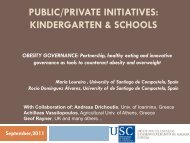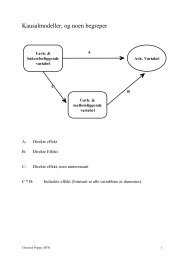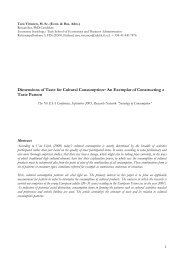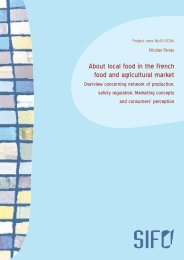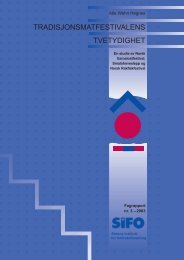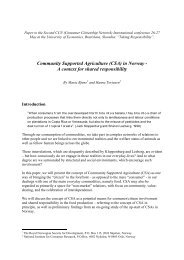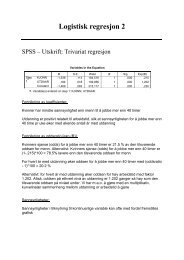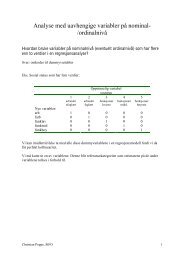Social Constraints to Eco Efficiency: Refrigerators and freezers - SIFO
Social Constraints to Eco Efficiency: Refrigerators and freezers - SIFO
Social Constraints to Eco Efficiency: Refrigerators and freezers - SIFO
Create successful ePaper yourself
Turn your PDF publications into a flip-book with our unique Google optimized e-Paper software.
ESA Conference; Torun, September 05.Pål Str<strong>and</strong>bakken, National Institute for Consumer Research, Norway<strong>Social</strong> <strong>Constraints</strong> <strong>to</strong> <strong>Eco</strong> <strong>Efficiency</strong>: Refrigera<strong>to</strong>rs <strong>and</strong> <strong>freezers</strong>IntroductionUnder the general heading of <strong>Eco</strong>logical Modernisation (Weale 1992, Hajer 1995, Spargaaren1997, Young ed. 2000, Mol & Sonnenfeld ed. 2000), improved eco efficiency of householdappliances has been regarded as an important contribu<strong>to</strong>r <strong>to</strong> the greening of modern lifestyles.The point of division between radical environmentalists (Durning 1992) <strong>and</strong> advocatesof ecological modernisation might indeed focus on the question of whether or not the move<strong>to</strong>wards a sustainable product culture is a sufficient answer <strong>to</strong> the ecological challenge. Is itpossible <strong>to</strong> transform western lifestyles by a technological fix? Is the environmentalmovement just conservatively clinging <strong>to</strong> seventies’ ideas about sacrifice <strong>and</strong> individualsuffering, failing <strong>to</strong> recognise that the situation has changed?The paper analyses the basis of such claims <strong>and</strong> counterclaims for the consumptionarea of refrigera<strong>to</strong>rs <strong>and</strong> <strong>freezers</strong>; appliances that account for a significant share ofhouseholds’ domestic energy use. The contribution is mainly from a sociology ofconsumption point of view, taking account of some empirical sociological material in a fieldthat might have been dominated by engineers’ technical <strong>and</strong> theoretical logic <strong>and</strong> the moralperspectives of environmentalists.Efficient cold appliances“The super-refrigera<strong>to</strong>r revolution has only just begun” (“Fac<strong>to</strong>r Four”; Weissäcker, Lovins& Lovins 1997, p. 36). Taking 1972 as their reference year, Weissäcker et. al. show thatimprovements in refrigera<strong>to</strong>r technology achieved an 86% reduction in energy per litre, fromUS average <strong>to</strong> best available technology in 1983 (pages 34-35). By reviewing a set of furtheroptions, including better compressors, more advanced insulation, better design <strong>and</strong> others,they claim that savings should reach 95% (p. 36). Refrigera<strong>to</strong>r improvement is one of TwentyExamples of Revolutionising Energy Productivity (Chapter 1). In an earlier example theymention that “the best freezer in the Danish market in 1988 used about 64% less electricitythan the average then in use” (p. 30) <strong>and</strong> they add that an 80% reduction could be readilyachieved (ibid.). This is surly good news for the environment, as well as for the rather affluentwestern consumers. Similar improvements in energy efficiency are occurring <strong>and</strong> should bereviewed for products like washing machines, light bulbs, mo<strong>to</strong>r vehicles <strong>and</strong>systems/appliances for space heating <strong>and</strong> cooling. Lifestyles might be made more sustainable,apparently without considerable citizens’ effort. Maybe we will be able meet theenvironmental challenge effectively by a technological fix?
2The EU Energy label (Rubik & Frankl ed. 2005) is an effort in a similar direction; apractical-political attempt at transforming western lifestyles in this more sustainable direction.It is perhaps rather more modest than the Fac<strong>to</strong>r Four visions, but Energy labelling isinfluencing the behaviour of a great number of individuals or households, as well as changingindustry. Slowly, the least efficient household appliances are phased out of the Europeanmarket. The aggregate effect of this change should be reduced energy use, meaning reducedcarbon dioxide emissions.If we generalize from this theoretical model of increased energy efficiency of consumerappliances, then, we should expect the improved products gradually <strong>to</strong> replace inefficien<strong>to</strong>nes. After a while, households’ consumption of energy for cooling <strong>and</strong> freezing foodstuffsshould decrease. How fast this effect will come in<strong>to</strong> being depends on the replacement ratesfor <strong>freezers</strong> <strong>and</strong> refrigera<strong>to</strong>rs. This is perhaps even better than effortless sustainability,because the consumer saves money as well, due <strong>to</strong> reduced electricity bills.The materialFor the author, the National Institute of Consumer Research (<strong>SIFO</strong>) <strong>and</strong> for the University ofTromsø, Norsk Gallup Institutt a/s in December 1998 conducted a nationally representativetelephone survey <strong>to</strong> 1025 respondents on questions of product durability. The survey wasfinanced by the Norwegian Research Council.Covering refrigera<strong>to</strong>rs, <strong>freezers</strong>, TVs <strong>and</strong> stereos, the survey focus on questions of thenumber of years the household has had its present product, how it was acquired, the reasonsfor replacing the previous product if the household has replaced an older product <strong>and</strong>, if it has;what happened <strong>to</strong> the obsolete product. The research was conceived as study of productdurability <strong>and</strong> possible effects of durability for the environment.Is long lifespan or quick product exchange beneficial for the environment?The basic assumption is that generally, it is environmentally advantageous <strong>to</strong> increase the lifespan of products.Product durability is an old theme in research on the environmental effects of consumption(Cooper 1994, Cooper & Mayers 2000, Heiskanen 1996, Hille 1993, Str<strong>and</strong>bakken 1997 <strong>and</strong>others). With some exceptions, the basic assumption seems <strong>to</strong> be correct. Most of theexceptions concern household durables that consume substantial amounts of energy in the usephase when more energy efficient alternatives are available, <strong>and</strong> the focal point of thediscussion is the relative size of the indirect energy component in consumption (Hille 1996).To a large degree, this controversy is limited <strong>to</strong> mo<strong>to</strong>r vehicles <strong>and</strong> washing machines,because they consume much energy when in use, <strong>and</strong> refrigera<strong>to</strong>rs <strong>and</strong> <strong>freezers</strong> because theyconsume energy continuously. At some point in such a product’s life span it may beadvantageous – from a <strong>to</strong>tal energy use perspective – <strong>to</strong> exchange the old product for a newone. To our knowledge, rather few detailed studies of such decisions have been published.One exception is mentioned by Heiskanen (1996, p. 12-13):The washing machine study she refers <strong>to</strong> concludes that a household that bought a newwashing machine in 1973, <strong>and</strong> exchanged it for a new one in 1983, in 1990 would haveconsumed less energy than a household that kept the old machine. Thus, <strong>to</strong>tal energy use isnot reduced until seventeen years in<strong>to</strong> the service life of the first product.This result depends on the exchange being done at the optimal point in time, withpurchase of state of the art technology. This does not mean, however, that one should changewashing machine every tenth year. That decision will have <strong>to</strong> take account of the rates of
3energy efficiency improvement for the specific product type in the given period. Theenvironmental choice between durability <strong>and</strong> energy improvement is not easy, not even forthe households’ most energy consuming machinery. What we are able <strong>to</strong> say, however, is thatwhen a product anyway is about <strong>to</strong> be replaced, the consumer should chose the energyefficient ones.The durability of the product, here defined as the number of years the average householdkeeps it before it is replaced, should indicate how long it might take <strong>to</strong> renew a givenpopulation of household machinery. Even at this rather simple level, we recognise thatproduct durability is a crucial constraining element in the eco efficiency revolution. If theaverage life span of a deep freezer is 10 years, the transition <strong>to</strong> more eco efficient <strong>freezers</strong>should take something like 10 years, provided that consumers replace their present modelswith the environmentally improved alternatives. Theoretically, this exchange could bespeeded up by introducing government subsidies for exchange, or by a price increase forelectricity, combined with information campaigns.There are however, as we will show further on, more obstacles <strong>to</strong> the efficiency revolutionthan the mere slowness of product exchange. Or we might state it differently: The exchangerate for cold appliances actually seems rather correct, given the “his<strong>to</strong>rical” pace of energyefficiency improvement. Energy efficiency of appliances is, however, not necessarily identical<strong>to</strong> the energy efficiency of consumption (Throne-Holst 2005).Consumption of refrigera<strong>to</strong>rs <strong>and</strong> <strong>freezers</strong> in NorwayWe have reasons <strong>to</strong> believe that the introduction of <strong>freezers</strong> as mass products in Norway israther similar <strong>to</strong> the rest of Western Europe (Shove <strong>and</strong> Souther<strong>to</strong>n 2001). We know lessabout the possibly different s<strong>to</strong>ries about refrigera<strong>to</strong>rs. In this context, however, the importantissue is that the market for refrigera<strong>to</strong>rs <strong>and</strong> <strong>freezers</strong> is saturated. In Norway, 98% of thehouseholds had refrigera<strong>to</strong>rs <strong>and</strong> 92% had <strong>freezers</strong> at the time of the survey (1998). Purchaseof cold appliances in Norway, as in the rest of Western Europe, is either for new householdsor it is replacement purchase. In our material, 86% of the refrigera<strong>to</strong>rs <strong>and</strong> 82% of the <strong>freezers</strong>were bought by their users as new products. The remaining was either bought second h<strong>and</strong>, orthey were gifts or inheritance.Table 1: Years since household’s acquisition of productRefrigera<strong>to</strong>r FreezerThis year (1998) 3 41-5 years 44 366-10 years 27 26More than 11 years 26 34Total 100/ N = 973 100/ N =910The average (mean) “age” – that is the number of years the object as been used in thehousehold – varied between 7.9 years for refrigera<strong>to</strong>rs <strong>and</strong> 9.4 years for <strong>freezers</strong>, with themedian value being 6 <strong>and</strong> 8 years. Median value is higher than mean value because somehouseholds own products that are very old. As mentioned above, even at this point we seehow troublesome ‘empirical consumption’ might turn out <strong>to</strong> be for the optimistic visions ofthe efficiency revolution. A substantial number of households have <strong>to</strong> be persuaded <strong>to</strong> speedup their exchange rates for appliances; in this instance refrigera<strong>to</strong>rs <strong>and</strong> <strong>freezers</strong>, for the
4technological fix <strong>to</strong> gain momentum. During our research, however, another obstacle becamevisible: Product resurrection <strong>and</strong> afterlife inside <strong>and</strong> outside the household.The replacement decisionRespondents that reported that they had exchanged fridge or freezer were asked why theydecided <strong>to</strong> replace the old one.Table 2. Reasons for replacing old product. PercentRefrigera<strong>to</strong>r FreezerObsolescence of quality (old product did not work anymore or 67 68was worn out)Obsolescence of function (old product lacked vital new functions) 4 2Psychological obsolescence (old product did not fit in or was 13 10unfashionable, respondent wanting something new)New consumer needs (like old product having the wrong size, or 16 20household split up due <strong>to</strong> divorce)100/N= 640 100/N=365In general, it seems as if consumers are reluctant <strong>to</strong> exchange products that work. In thesurvey, stereos were the exception. The technological change from vinyl <strong>to</strong> CD-technologymade as many as 44% of respondents <strong>to</strong> report obsolescence of function as the reason for thereplacement decision, but no such change has occurred in the fridge-freezer field. To a largedegree, this means that the present technical lifespan of white goods more or less determinethe delay of the efficiency revolution. And, as the aforementioned LCA of washing machinereplacement <strong>and</strong> energy use indicates, this might actually be rather acceptable from anenvironmental point of view. When efficiency improvements are quite modest <strong>and</strong> indirectenergy is systematically underestimated, this slow product exchange makes sense. To work<strong>to</strong>wards increasing product durability st<strong>and</strong>s out as a sensible approach <strong>to</strong> more sustainableconsumption, even when we consider products that consume energy in the use phase.Product afterlifeThe main concern here, however, is another – rather more serious - constraint or obstacle <strong>to</strong>the efficiency revolution; a constraint that not only slows down improvements but even worksagainst it (at least significantly undermines its results). In the survey, we raised the question ofwhat consumers did with the old product, if it still worked at the time of replacement buying.Table 3. What happened <strong>to</strong> the old product? Percent.Refrigera<strong>to</strong>r FreezerIt was sold 16 16Salvation Army, Flea market etc. 5 3Given <strong>to</strong> family or friends 24 25Placed in cabin, basement etc 21 11Thrown, delivered at retailers’ etc. 20 23Other 15 23Total 101/N=265 101/N=155Even if numbers here are rather small, the tendency is overwhelming. A minimum of 66% ofrefrigera<strong>to</strong>rs that worked when the household bought a new one is disposed of in a way thatprolongs its life. At least 17% of exchanged refrigera<strong>to</strong>rs <strong>and</strong> 8% of the <strong>freezers</strong> seem <strong>to</strong> be inuse as cold appliances after the acquisition of the new product. Real numbers are likely <strong>to</strong> be
5bigger, because both “delivered at retailers” <strong>and</strong> “other” might also include afterlife. Thismeans that <strong>to</strong> a large degree, energy efficient appliances add <strong>to</strong> the appliance population,instead of replacing inefficient ones.This is a kind of consumer behaviour that seriously threatens the perceived benefits of theefficiency revolution. The introduction of energy efficient cold appliances will contribute <strong>to</strong>the growth, not the reduction, of domestic energy use for cold appliances as long as thispattern prevails. The beneficial effects of the efficiency revolution are delayed until the nextexchange of the no. one fridges or <strong>freezers</strong>, when <strong>to</strong>day’s appliances are relegated <strong>to</strong>basement or cabin service. Unless we intervene in the market, i.e. by paying for taking oldproducts out of service, we might seriously delay the expected improved energy efficiency ofconsumption.The strange phenomenon here is that under “normal” conditions the exchange rate for coldappliances seems <strong>to</strong> fit rather well with the pace of technical improvement, but that themechanical simplicity of these products makes some of them extremely durable. This createsa situation where two solutions are rather acceptable from an environmental point of view:In the first instance the consumer keeps the product, after the point of optimalexchange, where savings in use energy makes up for the losses in indirect energy. Thediscrepancy between empirical <strong>and</strong> hypothetical energy use widens, but this happens ratherslowly. The household uses more energy than necessary, but the excess consumption isprobably not dramatic.In the second instance the old product is replaced by the new <strong>and</strong> improved product,hopefully at a point where direct energy use rather quickly makes up for the added use ofindirect energy. Even if this is not the case, because the exchange was not done anywherenear the optimal point, the empirical energy overuse is again not really dramatic.The observed pattern, however, is environmentally very undesirable. Instead of the technooptimist’svision of an immediate fac<strong>to</strong>r two improvement for cooling <strong>and</strong> freezing energyconsumption, we almost get a fac<strong>to</strong>r two worsening in a number of households for anindeterminate number of years.Deep ecology, technology <strong>and</strong> sociologyThis material is not sufficient <strong>to</strong> decide any sort of debate between radical environmentalistsdem<strong>and</strong>ing radical measures in order <strong>to</strong> adjust consumption <strong>and</strong> life styles on one h<strong>and</strong> <strong>and</strong>technical “fixers” on the other. The race between improved technology <strong>and</strong> increasedconsumption is unfinished <strong>and</strong> looks different in different consumption areas. Cars seem <strong>to</strong>get more <strong>and</strong> more efficient per weight unit, but they weigh more <strong>and</strong> more, they drive morekilometres <strong>and</strong> their number increase.So, when environmentalists tend underestimate the potential of ecologically improvedtechnology, the engineers seem <strong>to</strong> underestimate the problems of implementation. This littlestudy of white goods consumption <strong>and</strong> exchange rates in Norway shows that introduction ofimproved technology gets rather complicated <strong>and</strong> unpredictable when we move fromtechnical-economical models <strong>and</strong> in<strong>to</strong> thick social reality; without making that in<strong>to</strong> anargument against technical improvements.Technological improvement fools the environmentalist. Sociology fools the technician.
6LiteratureCooper, Tim (1993): Beyond recycling. The longer life option, London: The new economicsfoundationCooper, Tim & Mayers, Kieren (2000): Prospects for household appliances, SheffieldDurning, Alan (1992): How Much is Enough? The Consumer Society <strong>and</strong> the Future of theEarth, New York/London: W.W. Nor<strong>to</strong>n & CompanyMaarten A. Hajer (1995): The Politics of Environmental Discourse. <strong>Eco</strong>logical Modernisation<strong>and</strong> the Policy Process, Oxford: Clarendon PressHeiskanen, Eva (1996): Conditions for Product Life Extension, National Consumer ResearchCentre Working Papers 22: 1996, HelsinkiHille, John (1996): How we consume energy without ever noticing, Norges forskingsrådWorkshop 23. og 24. mai 1996, OsloMol, Arthur P.J. & Sonnenfeld, David A. ed. (2000): <strong>Eco</strong>logical Modernisation Around theWorld. Perspectives <strong>and</strong> Critical Debates, London/Portl<strong>and</strong>, Or: Frank CassRubik, Frieder & Frankl, Paolo ed. (2005): The Future of <strong>Eco</strong>-labelling. MakingEnvironmental Product Information Systems Effective, Sheffield: Greenleaf PublishingShove, Elisabeth & Souther<strong>to</strong>n, Dale (2001): Defrosting the Freezer. From Novelty <strong>to</strong>Convenience. A Narrative of Normalization, Journal of Material Culture Vol. 5, No. 3, 2001Spaargaren, Gert (1997): The <strong>Eco</strong>logical Modernisation of Production <strong>and</strong> Consumption.Essays in Environmental Sociology, Doc<strong>to</strong>ral Thesis, Wageningen: Wageningen AgriculturalUniversityStr<strong>and</strong>bakken, Pål (1997): Produktlevetid og produktkultur. En undersøkelse avforbrukeroppfatninger, <strong>SIFO</strong>-rapport nr. 6-1997, LysakerThrone-Holst, Harald (2005): From energy efficiency <strong>to</strong> efficiency of consumption, paper ateceee 2005 Summer Study; “Energy savings: What Works & Who Delivers?” M<strong>and</strong>elieu LaNapoule, FranceWeale, Albert (1992): The new politics of pollution, Manchester: Manchester University PressWeissäcker, Ernest von, Lovins, Armoury B. & Lovins, L. Hunter (1997): Fac<strong>to</strong>r Four.Doubling Wealth, Halving Resource Use. The New Report <strong>to</strong> the Club of Rome, London:EarthscanYoung, Stephen C. ed. (2000): The Emergence of <strong>Eco</strong>logical Modernisation: Integrating theEnvironment <strong>and</strong> the <strong>Eco</strong>nomy, London: Routledge



